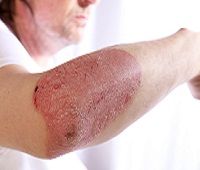Article
Guselkumab Effective for Treatment of Moderate-to-Severe Plaque Psoriasis
Author(s):
Researchers are learning more about the safety and efficacy of anti-interleukin-17 and anti-interleukin-23 (IL-23) therapy, although there are several agents currently under investigation. Anti-TNF agents and IL agents target psoriatic inflammation through different pathways.

Treatments for moderate-to-severe plaque psoriasis are plentiful, for sure; they run the gamut from topical therapy to phototherapy to biologics. In the latter category, there are a number of anti-TNF agents approved by the FDA for use and a great deal of clinical research on safety and efficacy. Less is known about the safety and efficacy of anti-interleukin-17 and anti-interleukin-23 (IL-23) therapy, although there are several agents currently under investigation. Anti-TNF agents and IL agents target psoriatic inflammation through different pathways.
A study recently published in the New England Journal of Medicine shows promising results in a Pphase II trial for the IL-23 antibody guselkumab. The study was a 52—week, randomized, double–blind, placebo–controlled, active–comparator trial comparing guselkumab (CNTO 1959), with adalimumab, which is often a front-line treatment in patients with moderate–to–severe plaque psoriasis.
A total of 293 patients were randomly assigned to receive placebo, adalimumab (standard dosage for psoriasis), or guselkumab (5 mg at weeks 0 and 4 and every 12 weeks thereafter, 15 mg every 8 weeks, 50 mg at weeks 0 and 4 and every 12 weeks thereafter, 100 mg every 8 weeks, or 200 mg at weeks 0 and 4 and every 12 weeks thereafter) through week 40, placebo, or adalimumab (standard dosage for psoriasis). At week 16, patients in the placebo group crossed over to receive guselkumab at a dose of 100 mg every 8 weeks.
Results were measured using the Physician’s Global Assessment (PGA) tool, wherein a score of 0 means cleared psoriasis and 1 indicates minimal psoriasis. At week 16, the proportion of patients with a PGA score of 0 or 1 was significantly higher in each guselkumab group than in the placebo group: 34% in the 5—mg group, 61% in the 15–mg group, 79% in the 50–mg group, 86% in the 100–mg group, and 83% in the 200–mg group, as compared with 7% in the placebo group (P<=0.002 for all comparisons).
Importantly, the proportion reaching a PGA score of 0 or 1 was significantly higher in the 50—mg, 100–mg, and 200–mg guselkumab groups than in the adalimumab group (58%) (P<.05 for all comparisons). At week 40, the proportion of patients with a PGA score of 0 or 1 remained significantly higher in the 50–mg, 100–mg, and 200–mg guselkumab groups than in the adalimumab group (71%, 77%, and 81%, respectively, vs. 49%) (P<.05 for all comparisons).
The study endpoints did not include a look at the impact on slowing or reducing the progression of joint damage in psoriatic arthritis, one of the key benefits of anti-TNF treatment.





